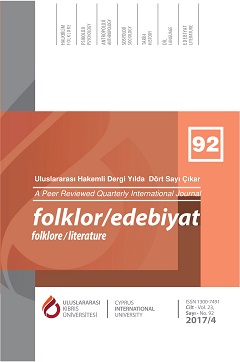Kahraman’dan Vah Aman’a Giden Yolculuk: “Kadinin Adi Yok” ve “Cam Kiriklari Parki” Romanlarinda Kadin Sorunsalinin Çocuk Dünyasi Üzerinden Karşilaştirmali Olarak Çözümlenmesi
The Spiritual Journey from the Here to Oh Dear! A Comparative Analysis of the Problematic of Women in “The Women Has No Name” and “The Broken Glass Park”
Author(s): Esin KumluSubject(s): Gender Studies, Social Philosophy, Novel, Comparative Study of Literature, Studies in violence and power, Hermeneutics
Published by: Uluslararası Kıbrıs Üniversitesi
Keywords: The Women Has No Name; The Broken Glass Park; women’s studies; feminist literary criticism; psychoanalytic criticism;
Summary/Abstract: Throughout the history, gender has always been discussed and analyzed. This topic has also found a place in literature, which is a reflection of sociology. In literary works, the roles such as of being a woman and a man or making a woman and a man, which are constructed by society, are the roots of the gender issue. The analysis of Alina Bronsky’s The Broken Glass Park (2013) and Duygu Asena’s novel The Woman Has No Name (1987) are very significant for the fact that the comparative reading of both texts helps the reader to analyze and realize the roots of violence against women. The reading process helps the reader to realize that, psychological and physical violence against women are related with the pressure upon gender roles constructed by society. In both novels, women’s problematic life which are are told by the narrators, who interpret their stories from the perspective of a child. Their stories foster a bridge between Germany, Europe, and Turkey as this enables a comparative analysis of the common cultural norms and differences between different geographies. The stories of the young girls can be symbolically interpreted through French psychoanalyst Jacque Lacan’s three stages to reach reality: The Imaginary, The Symbolic and The Real. Bronsky’s character Sasha, and Asena’s character, who does not have a name, first meet the symbolic order where they experience the reality of the father, which is the symbol of their communities. While Sasha tells her story from Germany, where her mother is killed by her stepfather in front of her eyes, the girl who does not have a name tells her story from Turkey through the perspective of her unhappy and submissive mother. In this stage, they meet the idea of the mother, and analyze their mother’s social status and place as a starting point of submissiveness of women. In the final stage, the characters reach the real order, where they create their own realities. Both of the characters support the idea that economic freedom and education are must in order to be happy as woman in life. The comparative analysis of the texts create a bond between the intercultural differences and common points of being a woman.
Journal: Folklor/Edebiyat
- Issue Year: 23/2017
- Issue No: 92
- Page Range: 121-139
- Page Count: 19
- Language: Turkish

